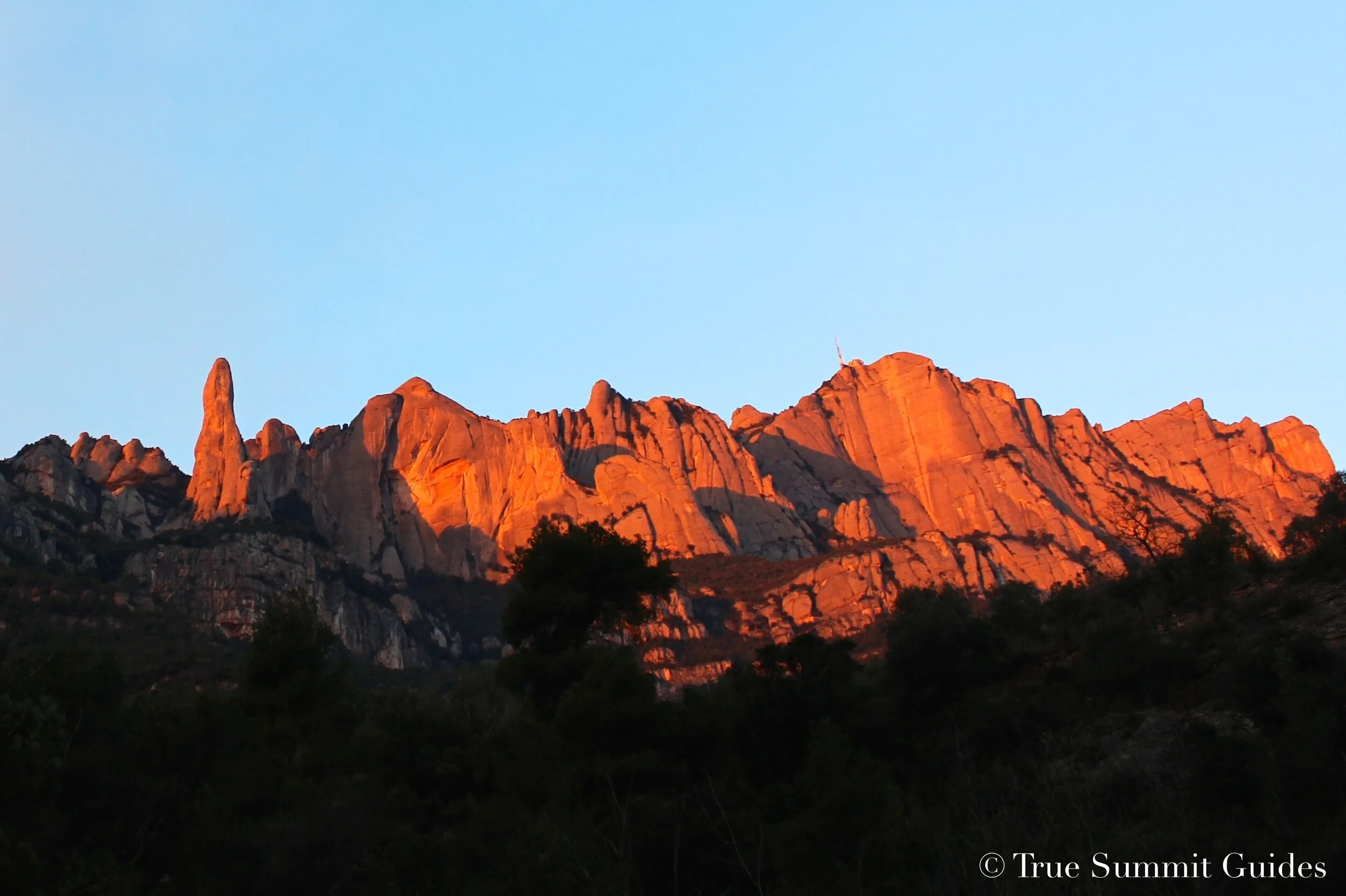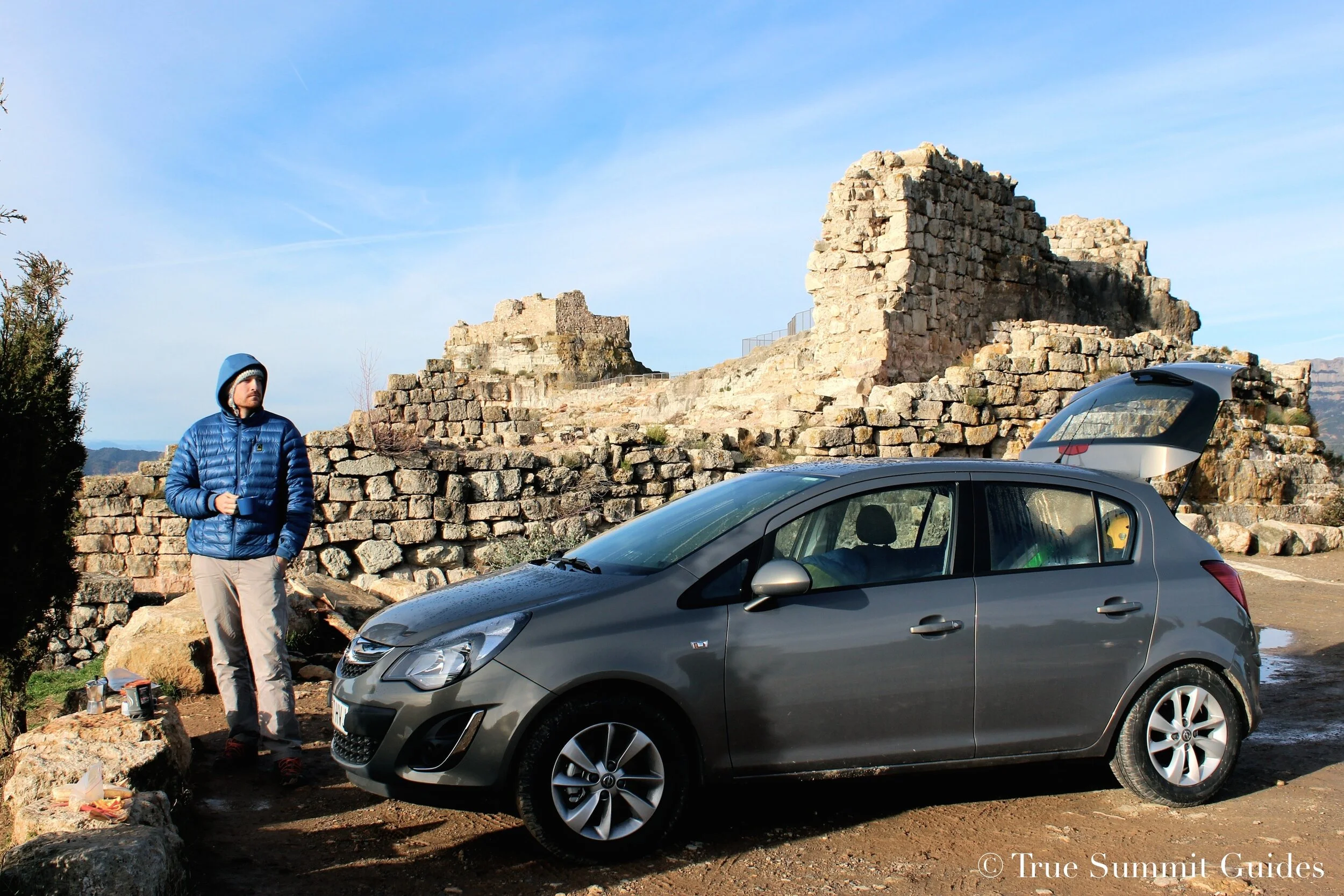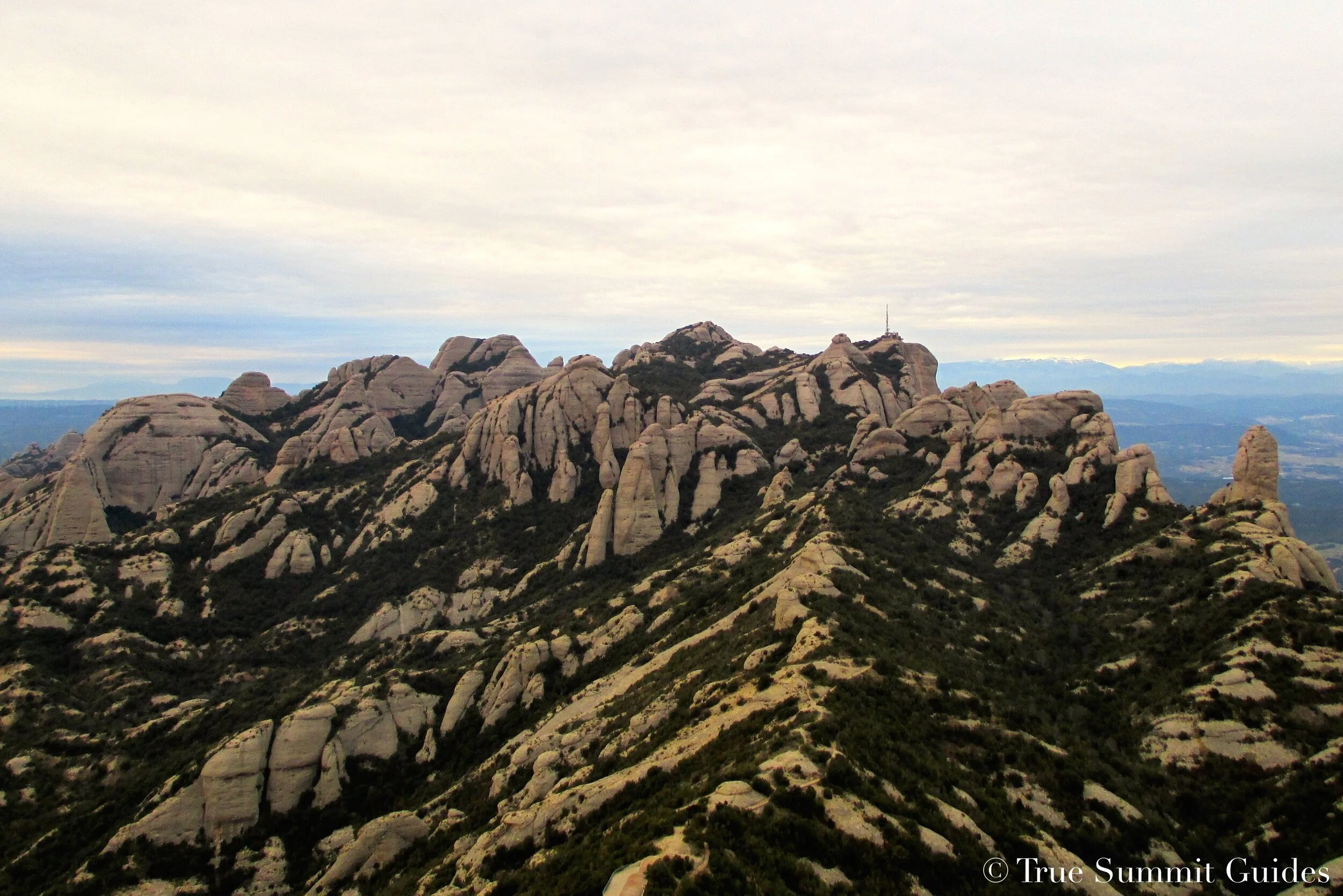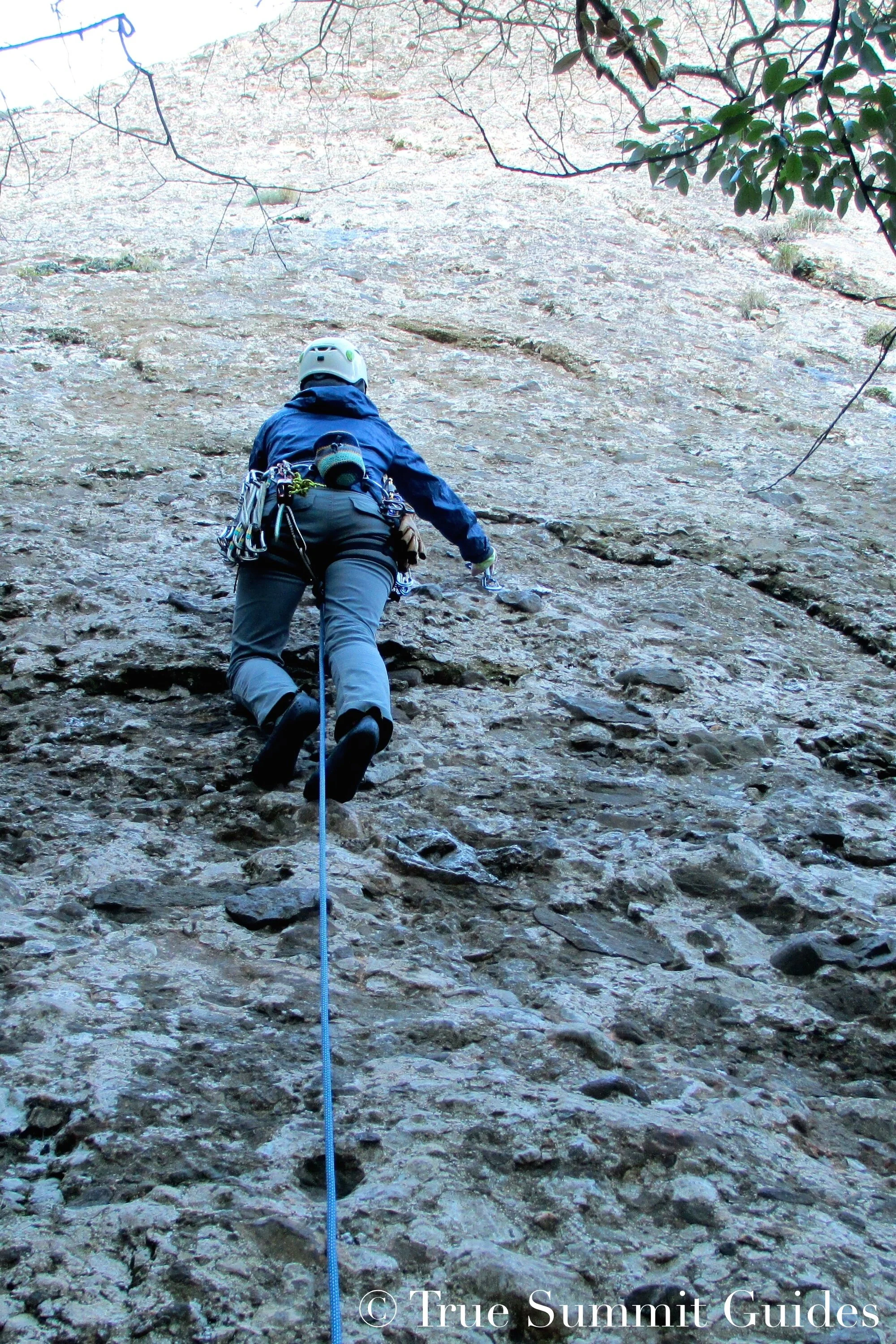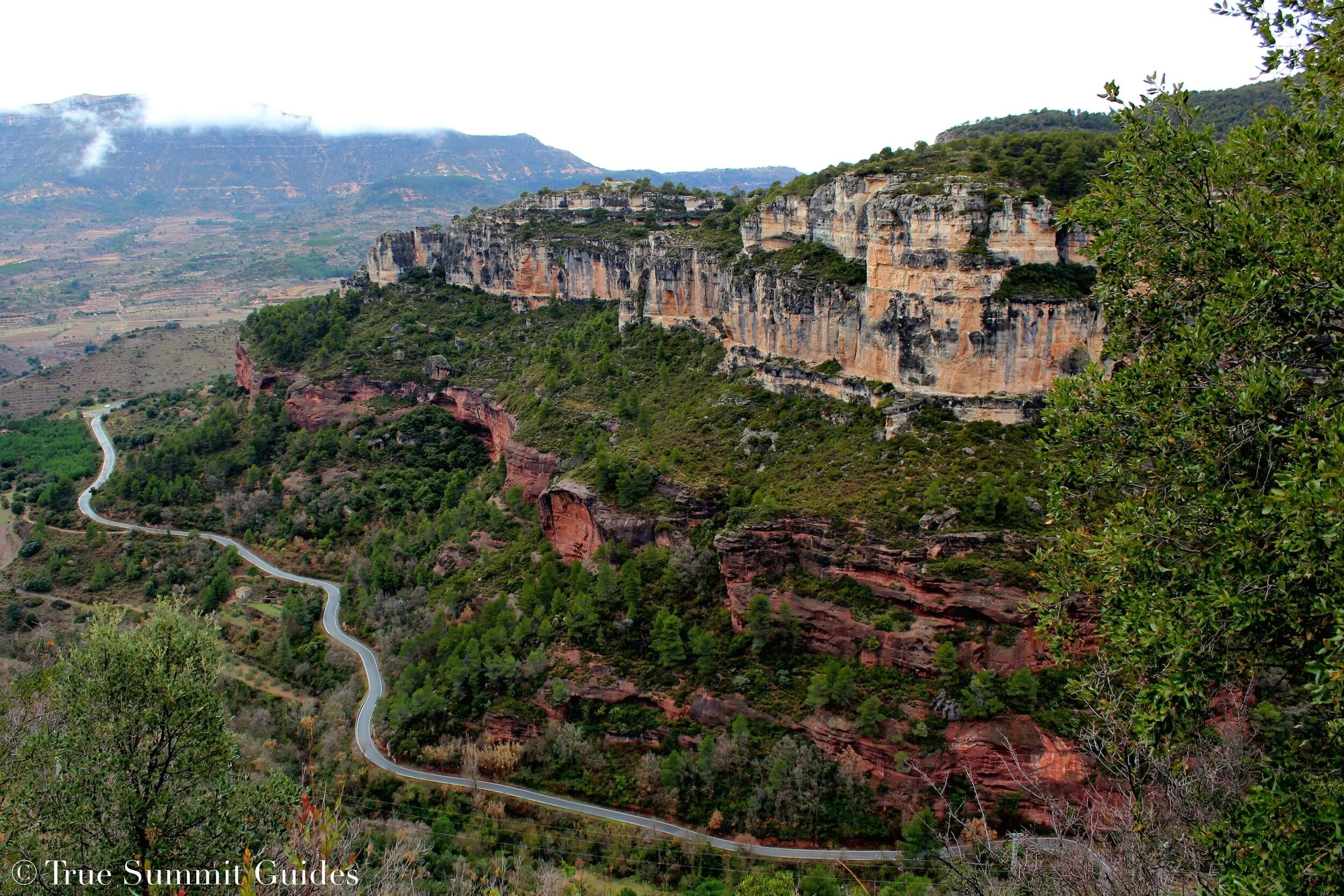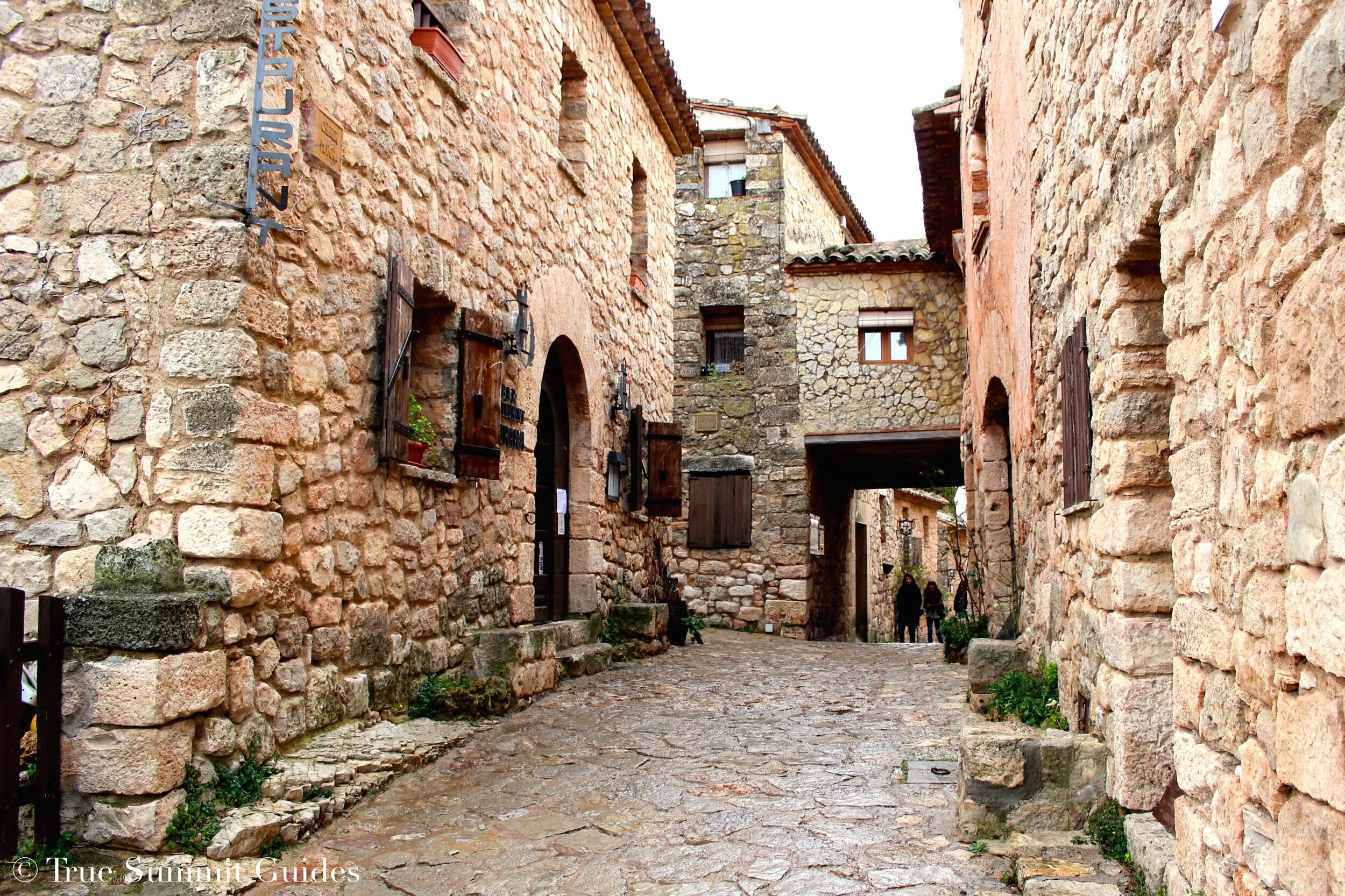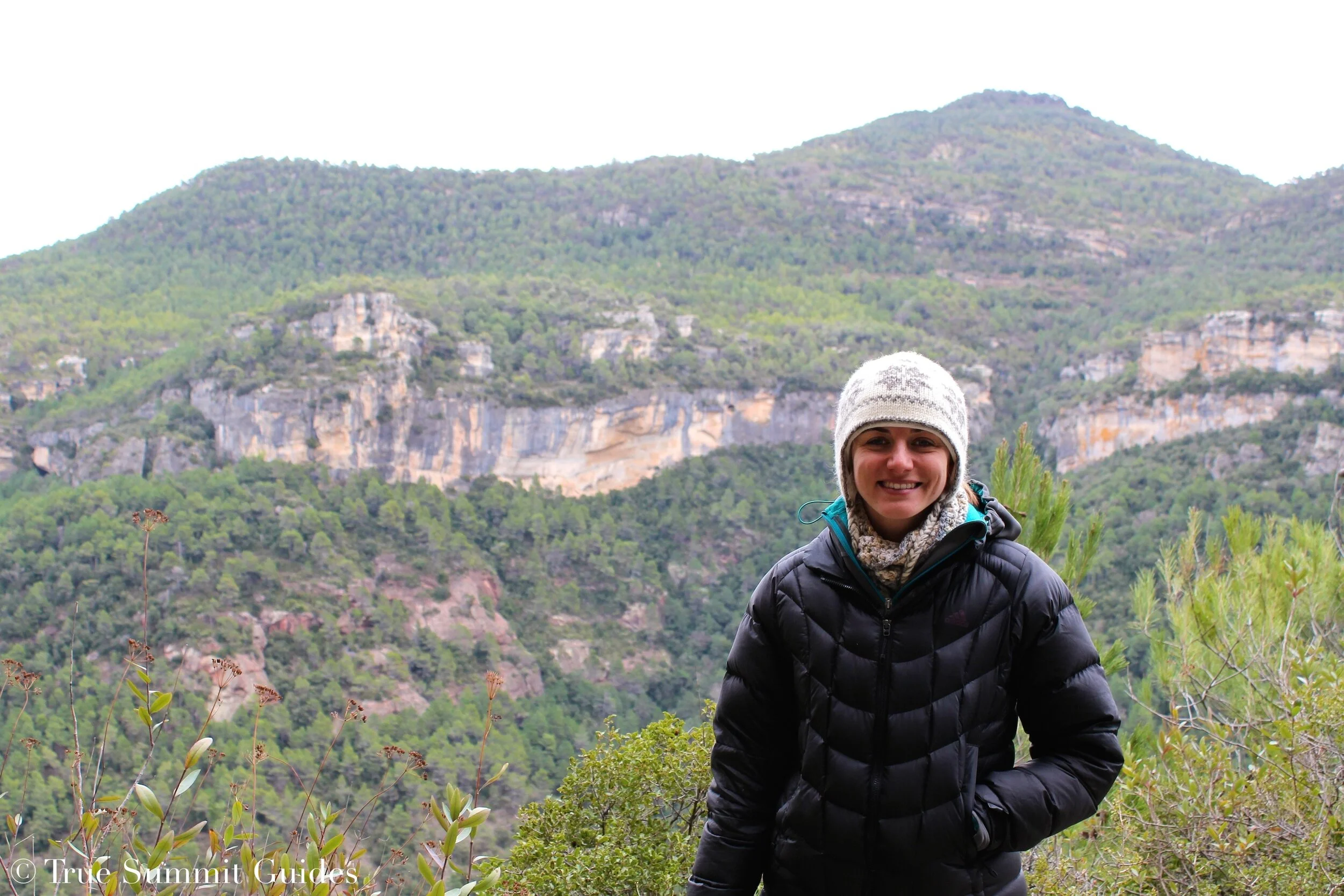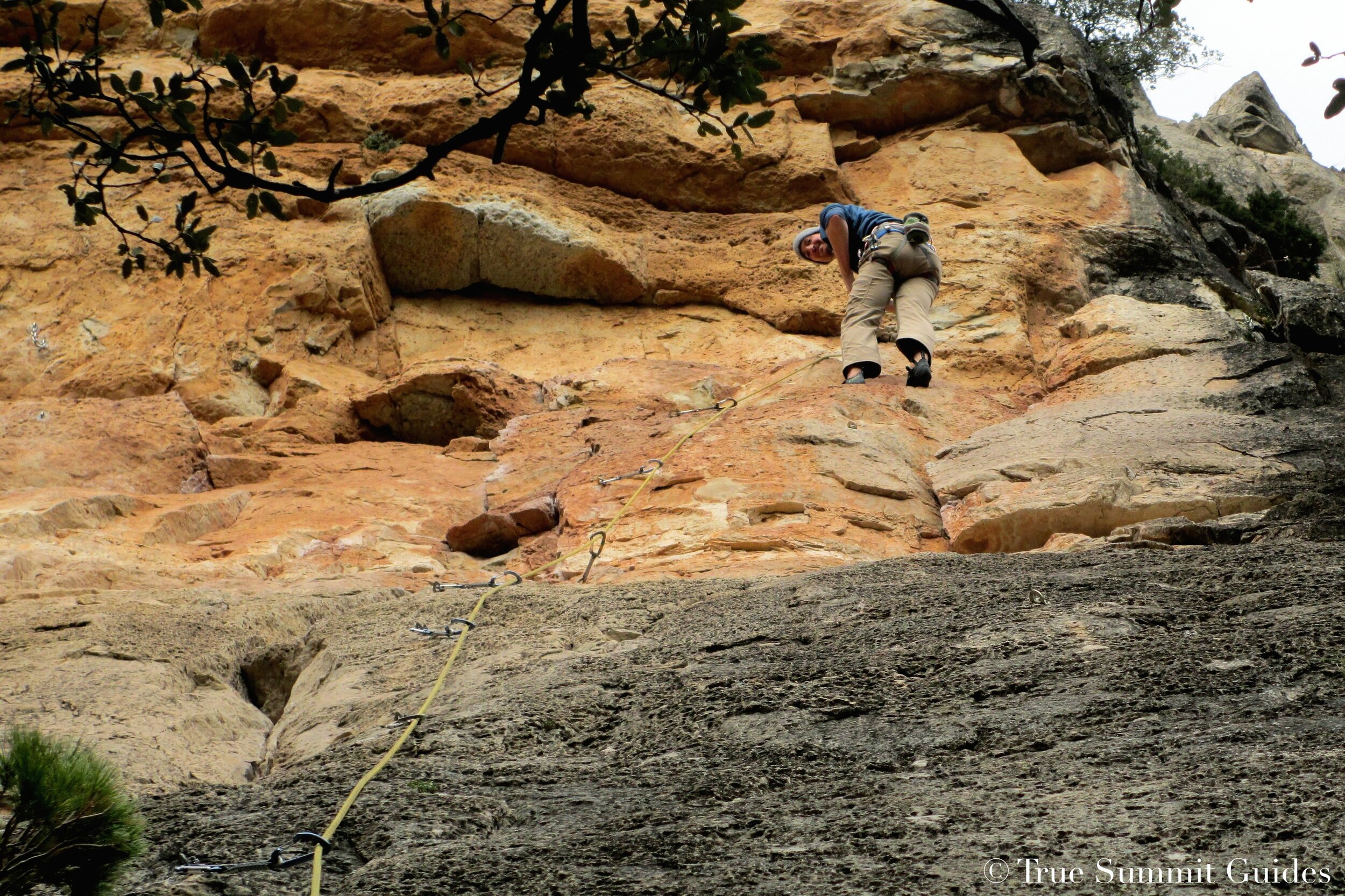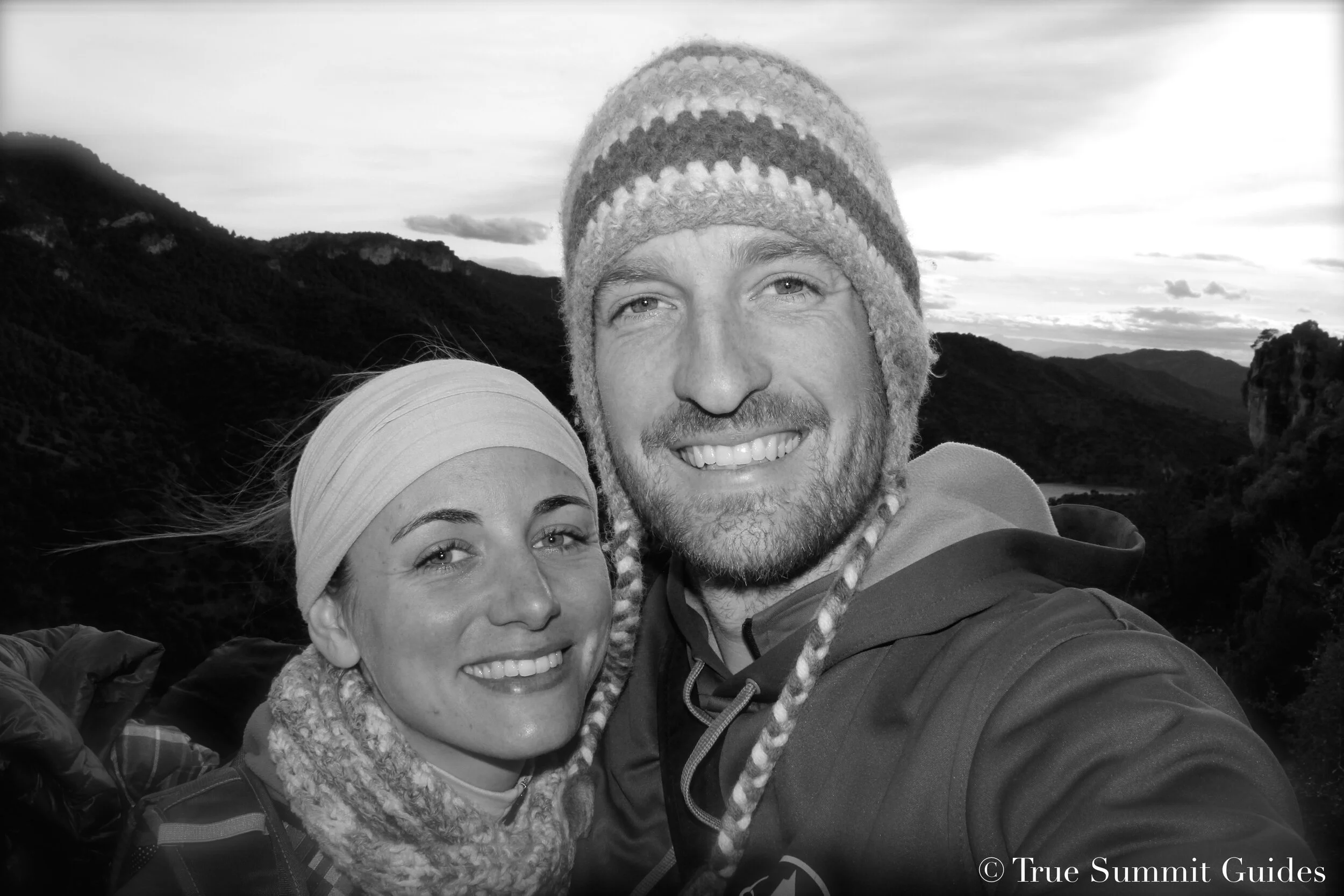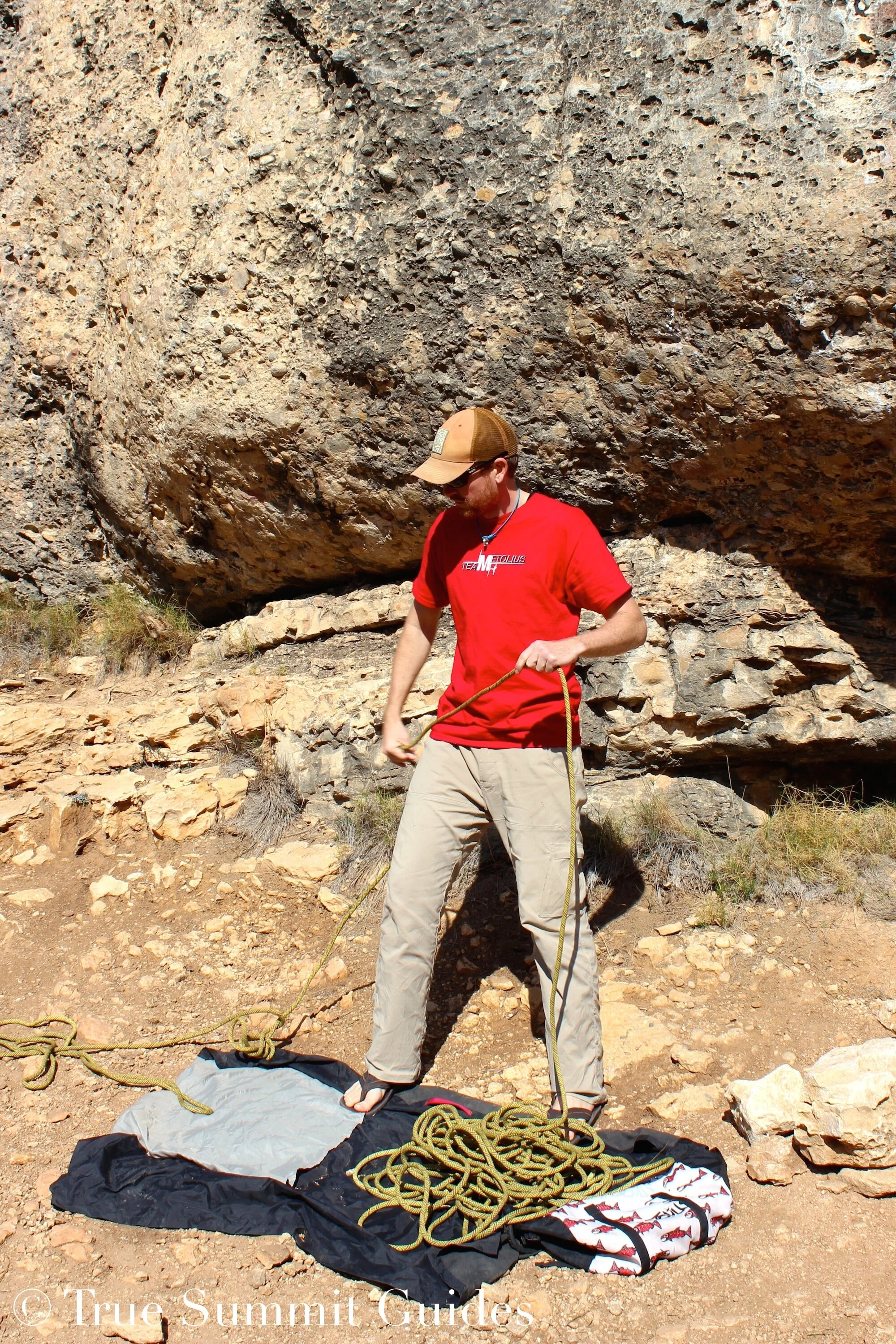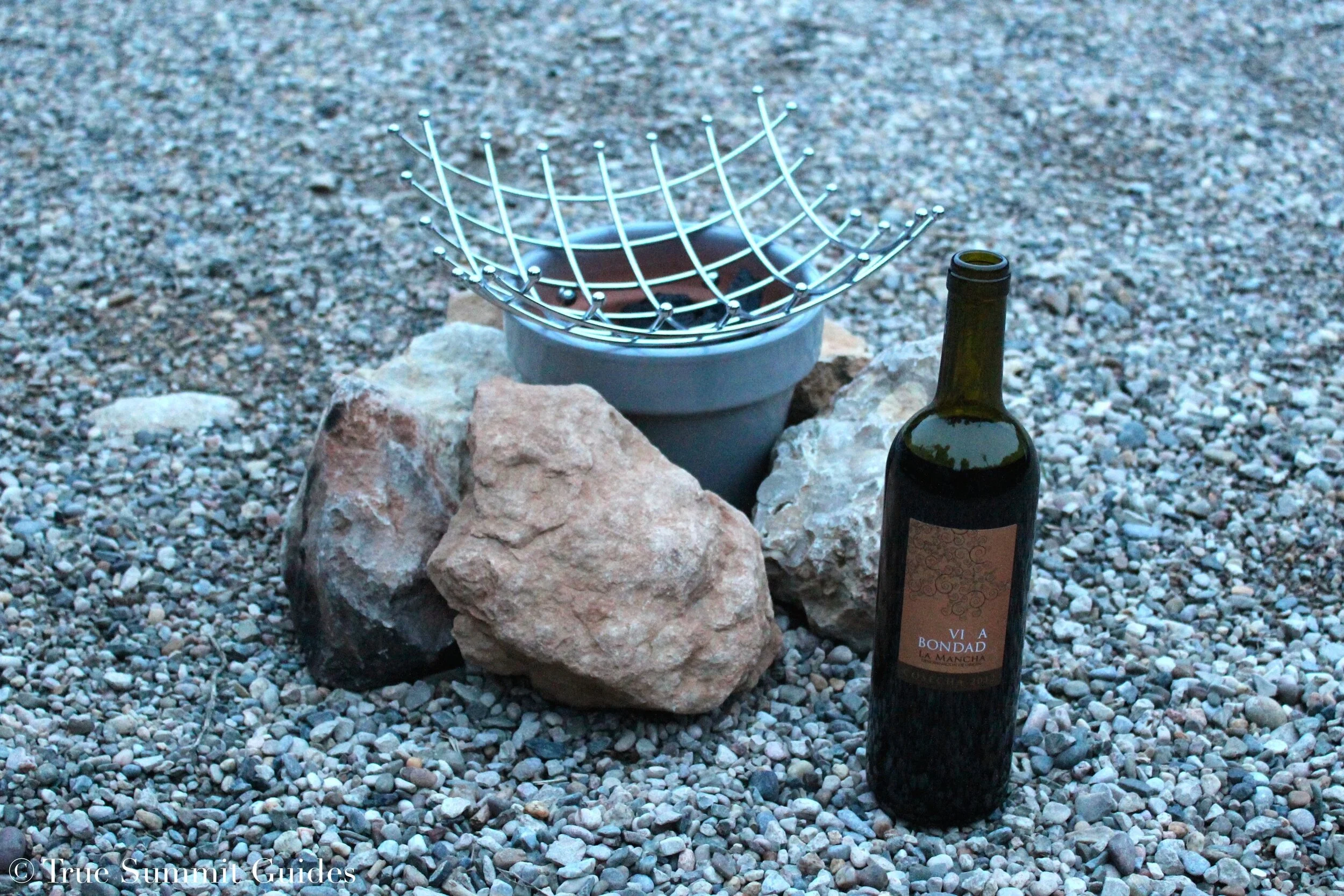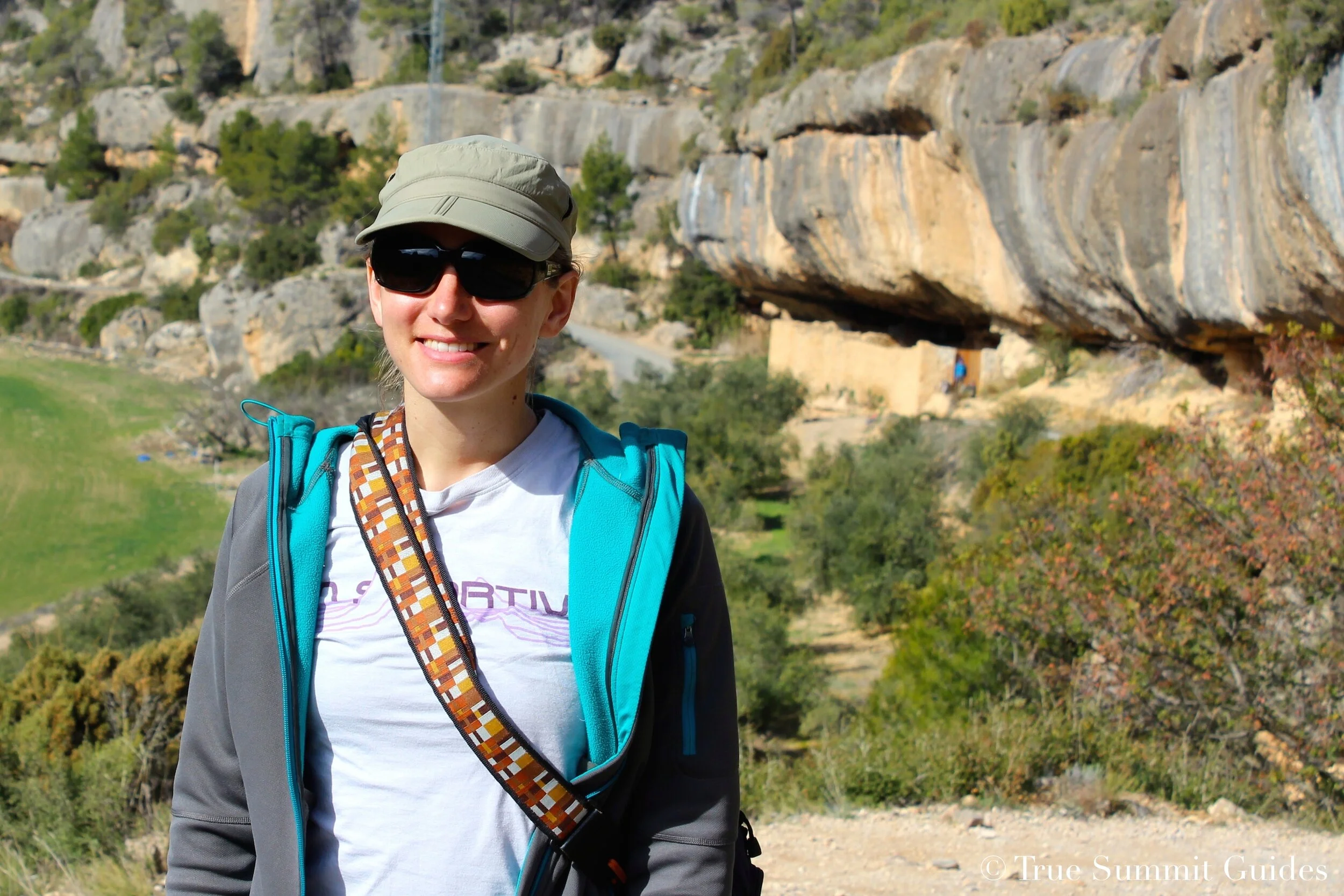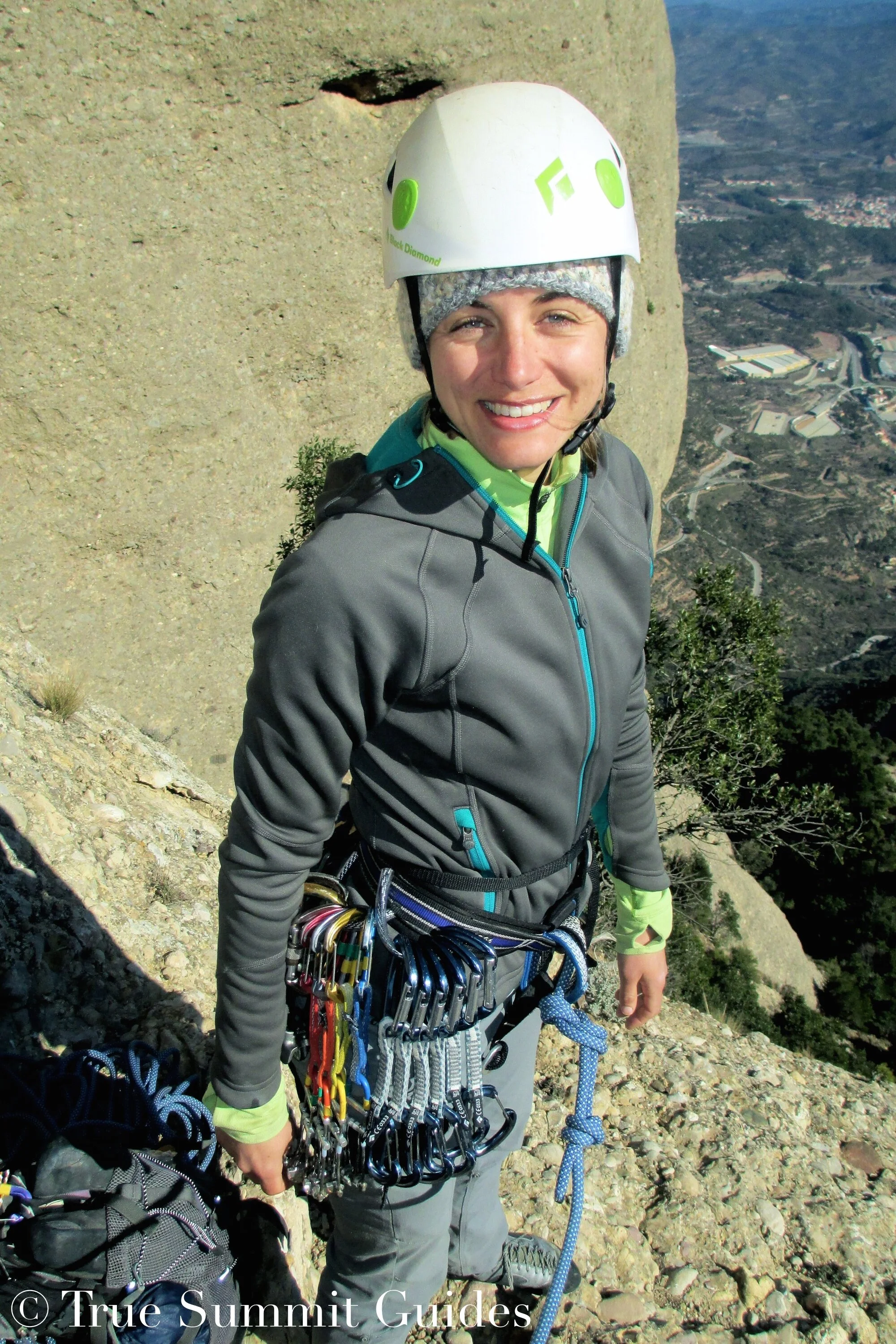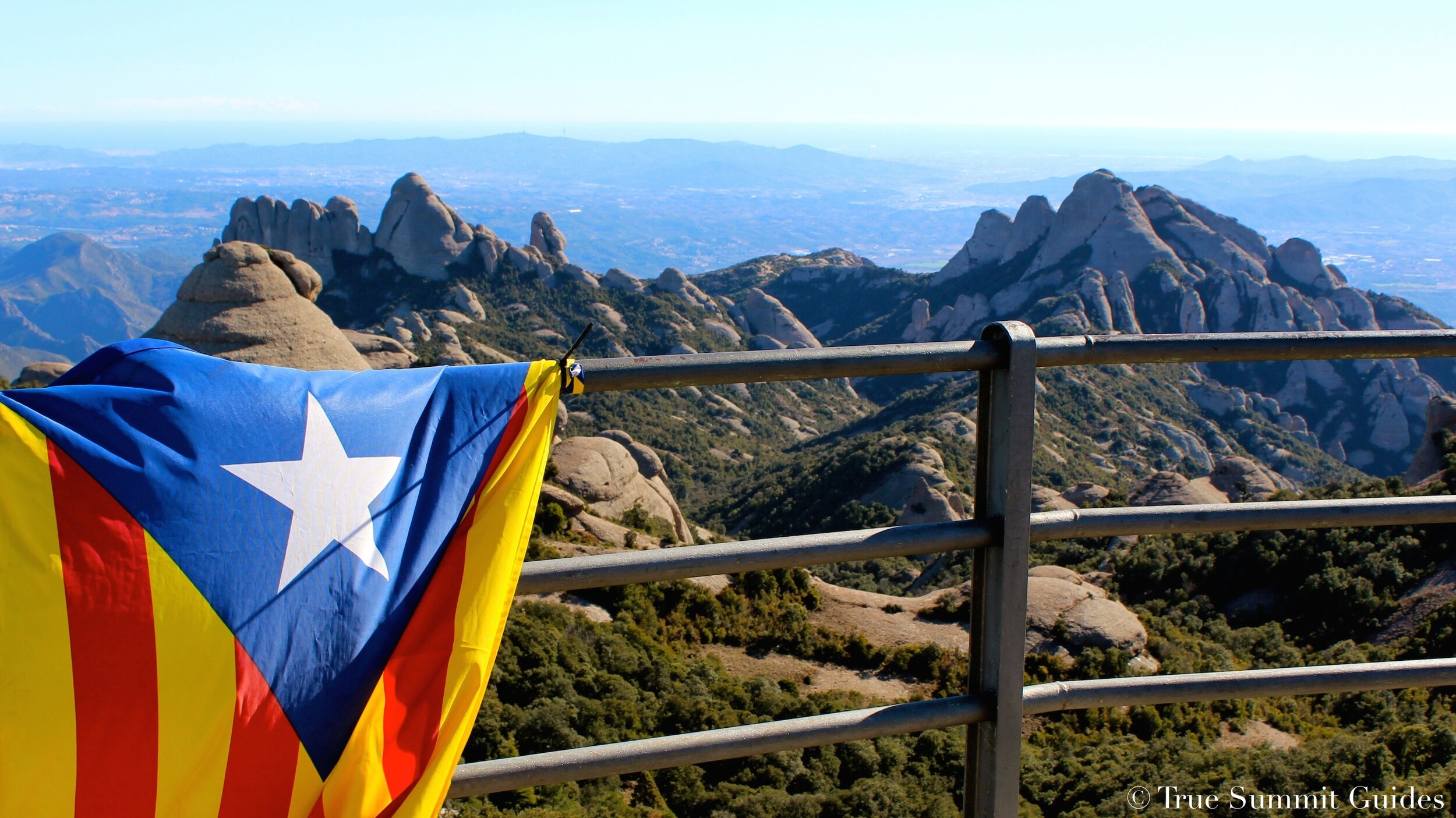French Dispatch #2: Escalada Esportiva España
The sun shines down upon my face and I am immediately greeted in the most friendly way by its warmth. I breathe in its nurturing and rehabilitating spirit as I emerge from our rental car with its windows dripping with the condensation of the previous night; they too feel the energy from this early morning light. As my eyes begin to adjust to the brightness, I peer up at the majestic sight displayed before me. Towering faces of rock, painted with hues of orange and yellow by the emerging sun, are unveiled rising 250 meters from where I stand. Rounded spires, sheer walls and protruding buttresses make up the spectacular cliffs above me, like a massive gothic cathedral built atop a mountain. I couldn’t help but wonder, “What is this place?”
These views were lost upon us the previous evening as we navigated our little Opel Corsa through a veil of darkness and dense fog. With little in the way of visual cues, we followed our trusty TomTom GPS up the curvy, switchbacked roads along the slopes of the mountainside. We parked on a pull off alongside the road behind what looked like a climber owned camper van, deciding this would be a suitable spot to spend the night. After a quick dinner and an attempt to make the most of the room afforded by the miniature interior of our mobile bedroom, we tucked in for the night just as the wind began to pick up. Throughout the night, the wind screamed and howled as if part of a thrilling Steven King novel, and I contemplated what it would be like to spend another couple weeks trying to make the most out of a stormy weather window. Astonishingly, as my body awoke to the calm tranquility offered by the sun soaked rocks and a windless morning, I knew that Spain would in fact offer safe haven from the winter storms we had experienced in Northern Europe.
Montserrat, Spain’s original National Park, translates literally to “Saw Mountain” due to its serrated edge shape drawn across the skyline. We arrived knowing little of what the area had to offer, aside from a few guidebook pages printed off the web that I was lucky enough to find translated into English. With only this small packet, exploring the region’s rock monoliths ourselves would provide a much needed sense of freedom. Although we enjoyed our time climbing the sandstone boulders of Fontainebleau, it is the formations of substance rising hundreds of feet above that really get my heart racing. In this mountainous playground, we would have plenty to keep us satisfied.
In addition to a wonderland of rock and interlacing trails, Montserrat’s most famous feature is the attention grabbing, tourist mecca of the Santa Maria de Montserrat. This Benedictine monastery perched up high and nestled in the rocks, accessible by car, tour bus, tramway and even cable car, seems to draw crowds from all regions of Spain and beyond. With its high elevation there are breathtaking views everywhere you turn, and dramatic bells that echo through the brilliant abbey and up into the mountains above. It is a truly majestic experience that everyone can appreciate.
To become aquatinted with this foreign rock fortress, we chose to spend our first day hiking the plentiful and well established trails in the park. As our first day happened to be a Sunday, everyone and their mother appeared to turn out in joining us with a day in the life of a tourist. Lucky for us, the countless stone steps spiraling passed the rear of the monastery slowly began to weed out the less hiking inclined, dressed in slacks and fashionable button-up coats, and we were once again in the company of similarly athletic, outdoor-minded individuals. As we ascended higher, the magnificent views made keeping a good pace difficult with the constant, unavoidable urge to snap photos at every opening in the trees.
After a handful of miles and about 2500 vertical feet we reached Sant Jeroni, the highest point on Montserrat, and took in the 360 degree view with sights to the snow capped Pyrenees, shining Mediterranean, bustling Barcelona and all the rolling fields, farms and villages in between. The vista was spectacular and well worth the knee torture received by the hundreds of stone steps to reach it. We were able to enjoy a hearty hike with the chance to scope out formations we had in mind to climb and the approach trails connecting them.
Although rich in culture from a traditional, ground-up style of first ascent ethics, dating back 70+ years, the majority of the routes in Montserrat are bolt protected because of the severely limited supply of crack systems. The more popular routes often see a smorgasbord of chopped and replaced bolts at each belay station from multiple generations of bolting and re-bolting. Conversely, if attempting a route less traveled, you will no doubt encounter run-outs of substantial distance between old, rusty, quarter-inch bolts with little to no options for traditional protection, save the slingable cobble every now and again. For the most part, on our chosen routes, we found the bolts to be fairly new and of a decent enough quality to deem trust worthy.
Although in the relative warmth of a Mediterranean controlled climate, it was still just the first week of February and our climbs would be limited to routes that received at least a moderate amount of sun exposure. When looking up to the skyline of rocks from the monastery, the most striking set of formations is a set of four mounds known as the Gorros, translated as “hats” due to their shape almost resembling the hats of garden gnomes. Our first climb would ascend the east face of the largest of these hats via the classic and original route called Badalona. This line, rated 5.8 R, follows the path of least resistance with its five pitches zigzagging their way up 700 feet to the summit. Although a fun and classic experience, the rope drag caused on the first two pitches due to the constant direction changes was a major bummer. Even with clipping minimal bolts and utilizing long slings over the course of the early pitches, I was quickly left wishing we had chosen a more direct path. Halfway up the face, our route crossed a modern and more direct line and I eagerly jumped at this opportunity. After two pitches of glorious 5.8 climbing up perfect quality cobblestones, with a short final pitch scramble, we reached the summit just as dusk was approaching and the winter sky offered an elegant show with a colorful sunset to reward our efforts.
As with all walks of life, there are moments to push it and moments to take it easy. Our ascent of Magdalena Inferior via La Que Hi Faltava (5.6) was as carefree as it was enjoyable. The smaller of its neighboring Gorro, the Magdalena Superior, this formation contains a number of quality routes around its circumference. Our chosen route appealed to us by ascending a direct line up the long, eastern face with some prospect of morning sun. For 350 feet we climbed three evenly spaced pitches, up a pleasantly direct line towards the rounded summit. The views from the top in the mid afternoon light were almost as good as the climb itself. Some might find a route like this too easy to be worth while, yet in contrast to always pushing our limits on single pitch routes, it is sometimes the straightforward ascents up several pitches of quality rock that can make for the most rewarding day.
Having only dabbled at the tip of the iceberg of the seemingly infinite formations to be climbed in Montserrat, it was difficult to think of leaving after only a handful of days. Alas, our time for the trip was rather finite and we still had other regions of Spain to explore. With a taste of the traditional and historical side of the Catalan climbing experience, our next stop would offer an indulgence of the modern, rappel-bolted sport routes near the old, stone village of Siurana.
With trusty TomTom avoiding the pesky toll roads beyond our dirtbag budget, we set out on a slightly longer yet infinitely more beautiful route to Siurana. We spent two hours driving along winding country roads through the rolling hills, endless vineyards and quaint, old villages of beautiful Spanish countryside. Eventually our views opened to the limestone mecca of exposed cliff bands, molded and shaped by eons of erosion, that had brought us on this excursion. The lines of orange and white rock, contrasting abruptly with grey and black water stained streaks, offer great aesthetic appeal as they rise up from the valley below. Seeing these rocks with my own eyes conjured a satisfying feeling of belonging, after countless hours spent living vicariously through the films and articles of professional climbers attempting the world-class routes now before me. Granted my hands will not even touch the overhanging, power-endurance routes of La Rambla (5.15a), La Reina Mora (5.14d) or A Muerte (5.14c), but one can dream, right? Simply walking among these giants makes even the average climber feel as though they are a part of the same community as the elite athletes making these groundbreaking ascents.
As we drove into Siurana, the sun set over the brightly striped rocks and it was early evening by the time we rolled into the campground near the village. The Camping Siurana campground feels like home no matter where you come from. Retired climbing rope holds up small trees and fence posts, friendly cats and dogs happily wander the premises, and the owner of the campground sits at his desk in the internet room and talks about the weather with local climbers. Sharing a space amidst rocks and trees, with a bunch of likeminded climbers with similar ambitions, was incredibly comforting. Everyone was kind and respectful, offering cheerful greetings of “hola!” and “bon día!” in a variety of international accents. Coming from all different nationalities and origins, we were gathered together simply as climbers in the same place, sharing the same dream.
The campground was a much needed indulgence after a week of trying to find places to sleep in Montserrat. We planned to only stay two nights, and save money the rest of the week by setting up our tent each night in one of the big parking lots near the climbing areas. This is mostly how we managed in Montserrat, spending our nights either sleeping in our car or, after finding a relatively tucked away spot for our tent, setting it up for the night and then packing up camp again in the morning. Although the hot showers, running water, internet access and comfortable cafe were all heartily welcomed, our biggest relief was simply in being able to establish a place for ourselves without worrying about having to move. We had a place for our tent, a place for our car and even couple of plastic chairs to sit in. What more could we ask for? The woman who checked us in was quite accurate in saying that rather than paying for our two nights up front, we would wait until we checked out, because “Who knows, you might stay two nights, you might stay two weeks!” Ten nights later, we finally checked out of our campsite.
Over the course of the following week, we spent our days tackling dozens of sport routes, mostly in the 5.10 range, on the stunning and well-protected walls flanking equally beautiful valleys. On some we achieved onsight success, on others we less than gracefully failed, but all along the way the smiles we carried stretched from ear to ear. This place was everything I had hoped and dreamed it would be! Although Siurana is known for its difficultly with routes from 5.12- to 5.14+, we found plenty to keep us busy in the 5.10-5.11 range. Some sectors offering more moderate grades are Esperó Primavera, Can Melafots and Can Marges de Dalt/Baix. If staying at the campground, Can Marges, Can Melafots and the classic test-piece sector Can Piqui Pugui are easily assessable via a 5-15 minute walk following paths across the road.
It rained a couple of times mid week, enabling us to partake in much needed rest days to rehabilitate our fingertips, torn up from the sharp crimps, without feeling as though we were missing out on quality days on the rocks. The wood cabin bar and cafe offered a cozy place to enjoy these days playing cribbage, chatting amongst our fellow climbers and listening to stories from the gracious pro climber and campground host, Toni Arbonés. The employees also never seemed to care if the campers ever ordered any food or drinks; anyone was welcome to read guidebooks, watch TV and escape the weather for as long as they liked. However it was pretty hard to resist the cheap, local Estrella beers, and for a hearty breakfast you could get a generous portion of tortilla de patatas as a sandwich within a half baguette. This first taste of a Spanish omelet would certainly not be our last of the trip, (nor would these be the last of our cheap Estrellas.)
With so much easily accessible, world-class climbing available, it was hard to say goodbye to Siurana, as we easily could have spent a month amongst its cliffs. Our only saving grace was the certainty of our making another pilgrimage to this venue a few years down the road, once our strength and ability improves to a level at which we can truly enjoy the difficult classics this region has to offer. We hope to one day come back for an entire season, swapping our tent and rental car for one of the countless camper vans we envied at every climbing area in Catalonia. Nevertheless, with an “hasta luego” to one dreamland comes a “bienvenido” to another, and we took the short drive across the Serra de Montsant mountain towards Siurana’s little brother, Margalef.
Although less developed than its neighbor, the cobblestone conglomerate walls of Margalef have made a name for themselves by containing more 5.14+/5.15 routes than the rest of Catalonia combined. Along with routes of this difficulty comes instant notoriety as elite climbers across the globe gather beneath massive overhangs to challenge short, yet ultra-powerful lines. Walking under the roof of the sector known as El Laboratori invokes a forearm pump without even placing hand to rock. Famous routes such as Demencia Senil (5.15a), First Round First Minute (5.15b) and Era Vella (5.14d) require dozens of efforts by professional climbers and challenge the likes of Dani Andrada, Chris Sharma and Sasha DiGiulian. Thankfully though, there are plenty of routes in Margalef to keep even us moderate sport climbers content, at sectors like Can Llepafils, Racó de les Espadelles and Cingle de les Solanes.
For the better part of a week, we made our home in the gravel parking lot below the dam that creates the Pantá de Margalef by restricting flow to the Riu de Montsant. Although camping in the parking lot is technically prohibited, it would take some convincing efforts to evacuate its fifty something temporary residents. Grateful for spacious and free camping, we set up our tent amongst the numerous camper vans that dominated the makeshift campground and caused much jealousy on our part by their comparatively “plush” accommodation. (One favorite was a beat up old van with its front bumper held on by duct tape and “Let the Good Times Roll” spray painted crudely in huge letters on the side.) From this parking lot, each of the routes we sought out were within a short hike and we were able to forgo using the car to get around. It’s difficult to top the feeling a climber gets waking up in camp, lazily enjoying breakfast and coffee, grabbing a pack and heading out to the crag only minutes away by foot. What is lost in the sense of adventure, is easily made up for in laidback, simple morning convenience. We quickly fell into the road trip climbers’ lifestyle of going to bed early and rising late. Graciously provided with the all day warmth of a winter sun, additionally benefited by our choice of south facing cliffs, we were able to get in a full day’s climbing late into each afternoon.
We did, however, have to get a little inventive with our cooking methods in Margalef. We were almost out of propane upon leaving Siurana, so on our drive out we figured we’d swing into one of the huge grocery stores (that sell everything) to buy a couple canisters. Turning up empty handed after the first few stores, we finally found a propane distributor who told us that our type of canister was not sold in Spain, and that we’d have to buy a whole new system. (This turned out to not be the case, as we found them days later in a climbing store heading out of Margalef.) However, not really wanting to spend the whole day hunting elusive fuel canisters, and certainly not wanting to spend the money on a new stove we would only use for a week and a half, we got a little creative. For 15 euros at a grocery store, we bought a clay flower pot, a bag of charcoal, a bottle of lighter fluid and a curved metal grate that I’m pretty sure was actually a decorative fruit basket. It worked pretty well; the flower pot cracked after the first use, but we just tried not to move it the rest of the days we were there, and it contained the hot coals well enough. Of course it was not nearly as fast and efficient as our little Jet Boil, but after about two hours of patient waiting and eating lots of snacks, we could have a fresh bowl of luke-warm pasta! It wasn’t perfect, but after a long day of climbing, a warm dinner is certainly better than a cold one, and we happily took what we could get.
Although I feel I would have a hard time claiming another Spanish crag to be more spectacular than the cliffs of Siurana, it was well worth our time to explore this area. Margalef offers a different style of climbing with its cobblestone texture that greatly contrasts the sharp limestone rock of Siurana. It is similar to suggesting that Joshua Tree, although clearly less majestic than Yosemite, provides a welcome difference in climbing experience compared to its northern granite cousin. Each region contains their own special gems and much of what makes the climbing lifestyle truly great lies in the opportunity to experience these precious stones first hand.
It was, in fact, the uncontrollable desire of another of these rocks that brought the conclusion of our climbing in Spain back full circle. While viewing the sawtooth skyline created by the Montserrat rock formations from the north, the eyes of climbers and tourists alike cannot help but be drawn towards the true gem of the range. Central and prominent, the breathtaking free standing spire of the Cavall Bernat rises up 750 feet from its sprawling base and dominates the already impressive ridgeline. After visiting Siurana and Margalef, the undeniable draw I felt towards this spire left me no choice but to return. To leave Catalonia without having summited this striking monolith would have simply been too much to bare. With two days left before we were due back in Barcelona, we re-navigated the Spanish countryside towards our original destination for one last hurrah!
Enriched by local tradition and history, the legendary spire became a symbol of Catalan climbing following the first ascent of the original route in 1935. Now known as the “normal route,” this line ascends just 300 feet up the shorter, southwest side of the spire. Our chosen line followed the stunning northeast profile for seven pitches of exposed, cobblestone delight. Named after its first ascent team in 1971, the Punsola-Reniu route marked a pivotal moment in Catalan climbing. It was not until this time that the free climbing abilities of local climbers reached a level of skill to attempt the run-out sections of the start of this route. Since then, the line has received numerous re-bolting efforts, including a bolt ladder on the steep upper pitches, and could now even be considered over bolted. In 1978, a club was formed called the Grup Cavall Bernat, thats only condition for admittance was (and still is) that the member have summited the Cavall Bernat.
The NE face follows a low angle slab for four pitches, steepening as you ascend, with a difficulty reaching 5.9. Pitches five and six involve steep climbing on small, polished holds with multiple short, overhanging sections, reaching a difficulty of 5.11b. The final pitch follows a steep traverse to the right and a lovely 5.8 scramble up big cobbles to the summit. For the brave and fit, the route goes free at 5.11b. However, the average climber, including us, can use aiders to ascend the strenuous upper pitches, earning a grade of 5.9 A0. The Punsola-Reniu route was a great pleasure for us both, with Noémi leading the first two pitches, me climbing the next two pitches free, and then aiding the difficult finale to reach the summit after an all-day endeavor.
Over the course of a final day hiking in Montserrat, we were able to reflect upon our time exploring Catalonia. The weather had been good to us aside from a few scattered showers and formidable winds, with enough days spent basking in rejuvenating warmth to keep up our morale. After spending the previous two months wearing down jackets and climbing frozen boulders in Fontainebleau, we certainly appreciated this Spanish winter climate and the ability to climb with the use of our fingers and toes. We experienced the simple joys of camping amongst the cliffs with short approaches in Siurana and Margalef, as well as the long approaches and adventure driven moments of the Cavall Bernat and other Montserrat formations. However, after 25 days of living out of our car and tent, it’s fair to say that we had earned a relaxing few days of tourism in Barcelona!
Upon arriving in Barcelona, we sadly said goodbye to our little Corsa and TomTom, who had been very good to us, and made our way to the Backpacker’s BCN hostel. Words cannot express how excited we were for bunk beds and hot showers, and the hostel was everything we dreamed it could be. Not only did it have huge lockers for our never-ending baggage and a community kitchen where we could make meals without wind, cold and dirt, it was even really nicely decorated! This is something that does not often come with cheap hostels. All of the furniture was made out of wood and it had a homey, outdoorsy feel with pine cones, flowers and stones decorating the walls, and framed photos of mountains and backpackers. It was also just a short walking distance from the center of the city, so we were able to see a great portion of Barcelona by foot in the three days that we were there.
Barcelona is an amazing city to walk around, with plenty to see without ever using a car or public transportation. We spent much of our time wandering around, marveling at all the Antoni Gaudí and modernista architecture. It is an incredibly visually interesting city with the curved balconies, brightly colored mosaics, asymmetrical layouts and overall ornate designs of this unique era of architecture. The city also places great importance on the availability of public open spaces and pedestrian walkways. Whether in the form of pavement or parks, there is an abundance of open spaces in which to walk, jog or lounge. And in busy areas, the middle of the street is often utilized with a wide lane for pedestrians, cyclists and even shops or restaurants. A wide street may have only one lane of traffic going each direction for cars, and a width of two or three lanes in the middle designated for pedestrian use. We found an amazing place for lunch on one of these streets near Gaudí’s awesomely bizarre Sagrada Família church. After witnessing the ornate overload up close, we enjoyed tapas and beer in direct view of the massive church and busy construction site. The city is still working to finish the ambitious project nearly 90 years after Gaudí’s death.
Over three days, we got to see a pretty good portion of the city. We walked down La Rambla, with all the other tourists, past numerous shops and a huge open air market. This led us to the coast, where we strolled along the boardwalk and sunny beaches to Port Olímpic. One afternoon, we stumbled across the Parc de la Ciutadella, full of locals just out of school and work. It was a warm afternoon, and we soaked up some sun on the grass in the midst of friendly locals playing guitar, kicking soccer balls and even slacklining. A walk past the insanely impressive Palau Nacional took us through the gardens of Montjuïc and up to the Castell de Montjuïc, a fortress built at the top of the hill with panoramic views of the city and bustling port below. Overall, it was a great end to our Catalonia adventure, summing up our month with the easygoing, open-minded and creative lifestyle of Catalan culture.
We definitely experienced a different level of adventure over this month in Spain. Without a roof to protect us or keep us warm, and sometimes without any idea of where we were going to spend the night, we made do with what we had and always tried to keep an open mind and carefree attitude. We lived simply and inexpensively, enjoying mostly grains, canned foods, fruits and peanuts from local grocery stores. Not to mention, really cheap Spanish wine. We made do without landromats and showers, but enjoyed fresh espresso every morning via our stovetop percolator. From the top of cliffs and spires, we marveled at views we never could have seen otherwise. We pushed ourselves on challenging sport routes, and climbed up into the elements on long multi-pitches. We watched the original Star Wars trilogy from the comfort of our down sleeping bags, and spent Valentine’s Day sipping cold beers in the warm sunshine. We improvised when things went wrong, and met incredibly helpful and friendly climbers along the way. Most importantly, we did our best to immerse ourselves in the spectacular natural environment that surrounded us, and to always appreciate what we had and where we were.

